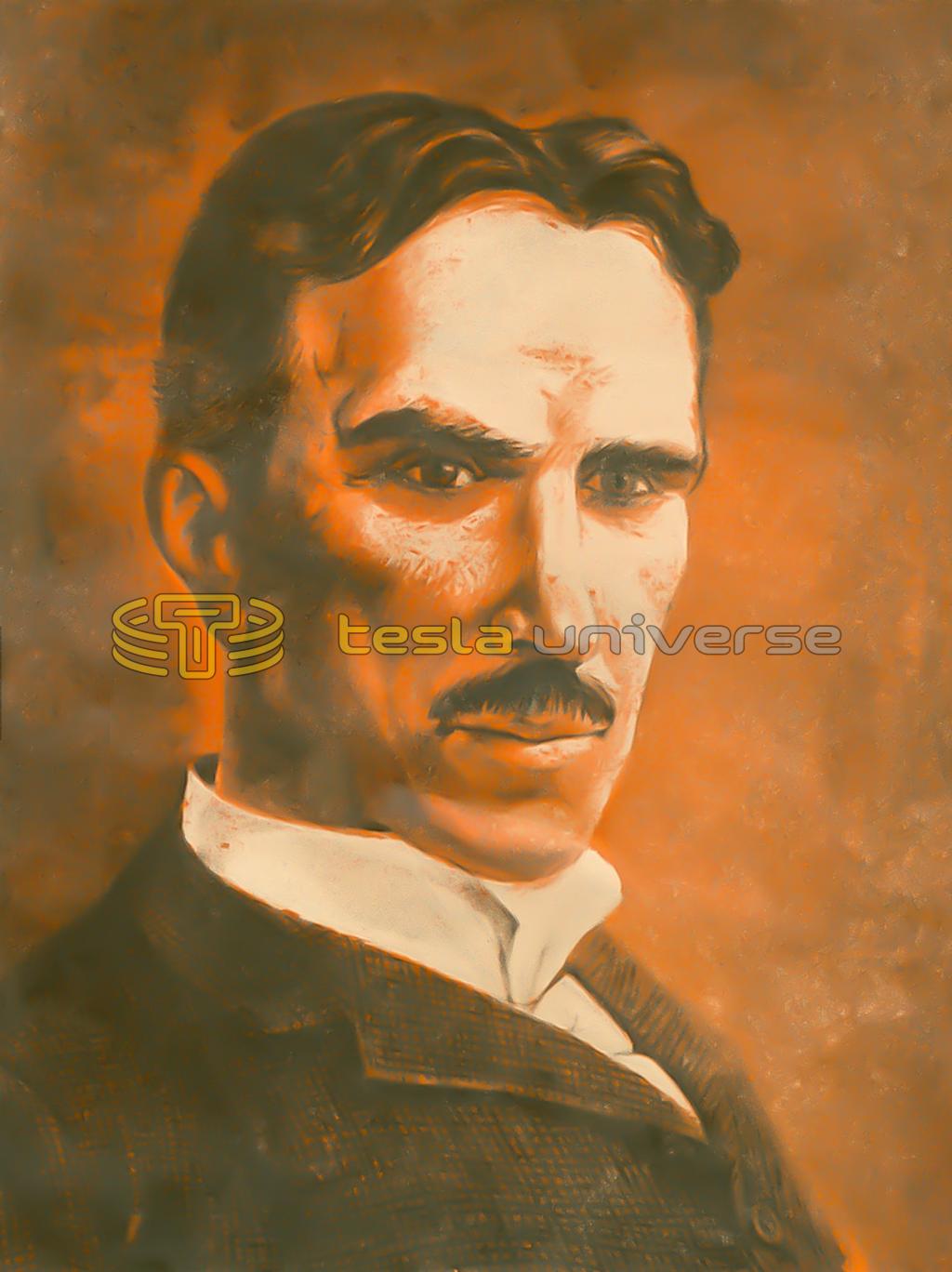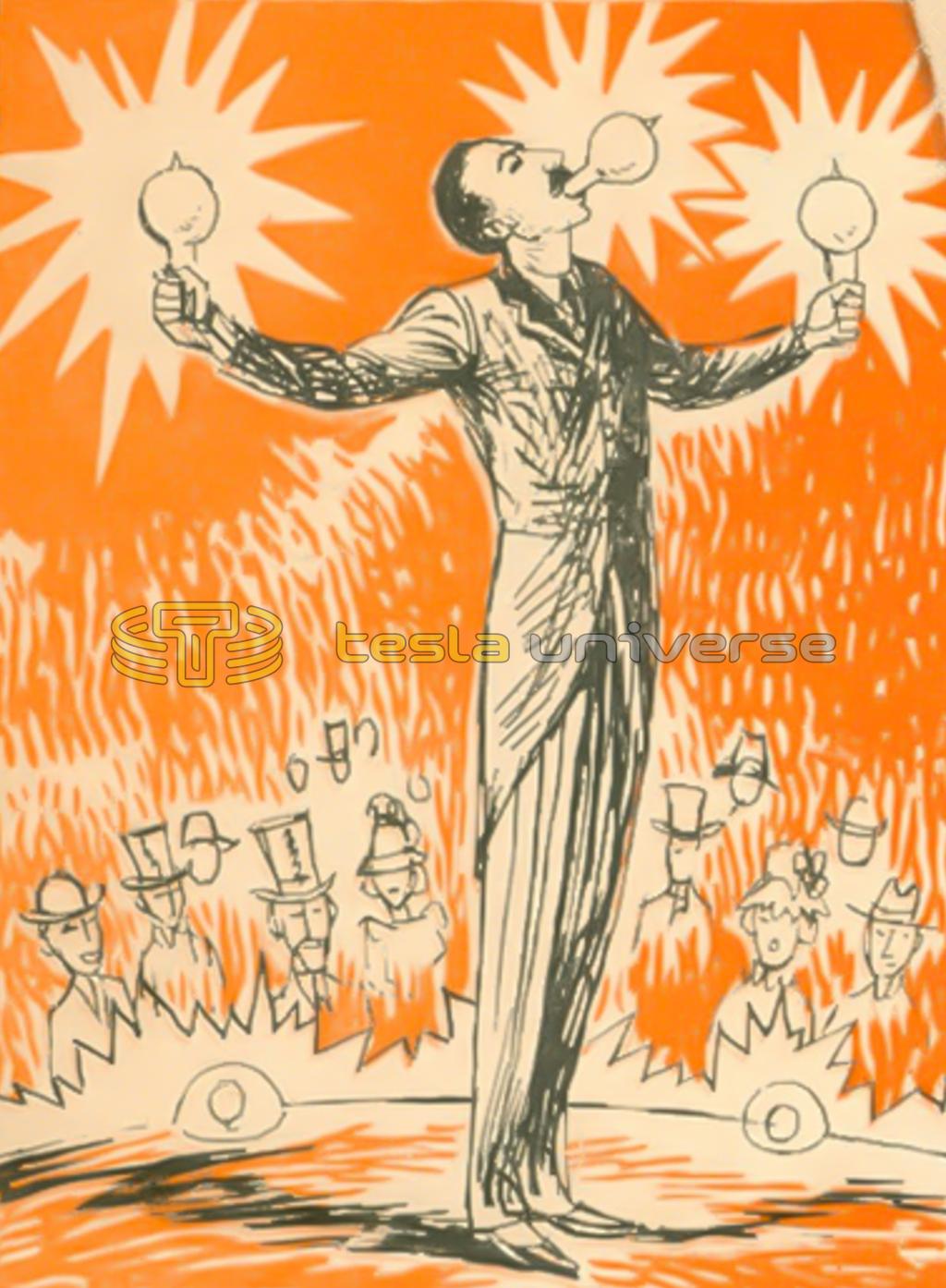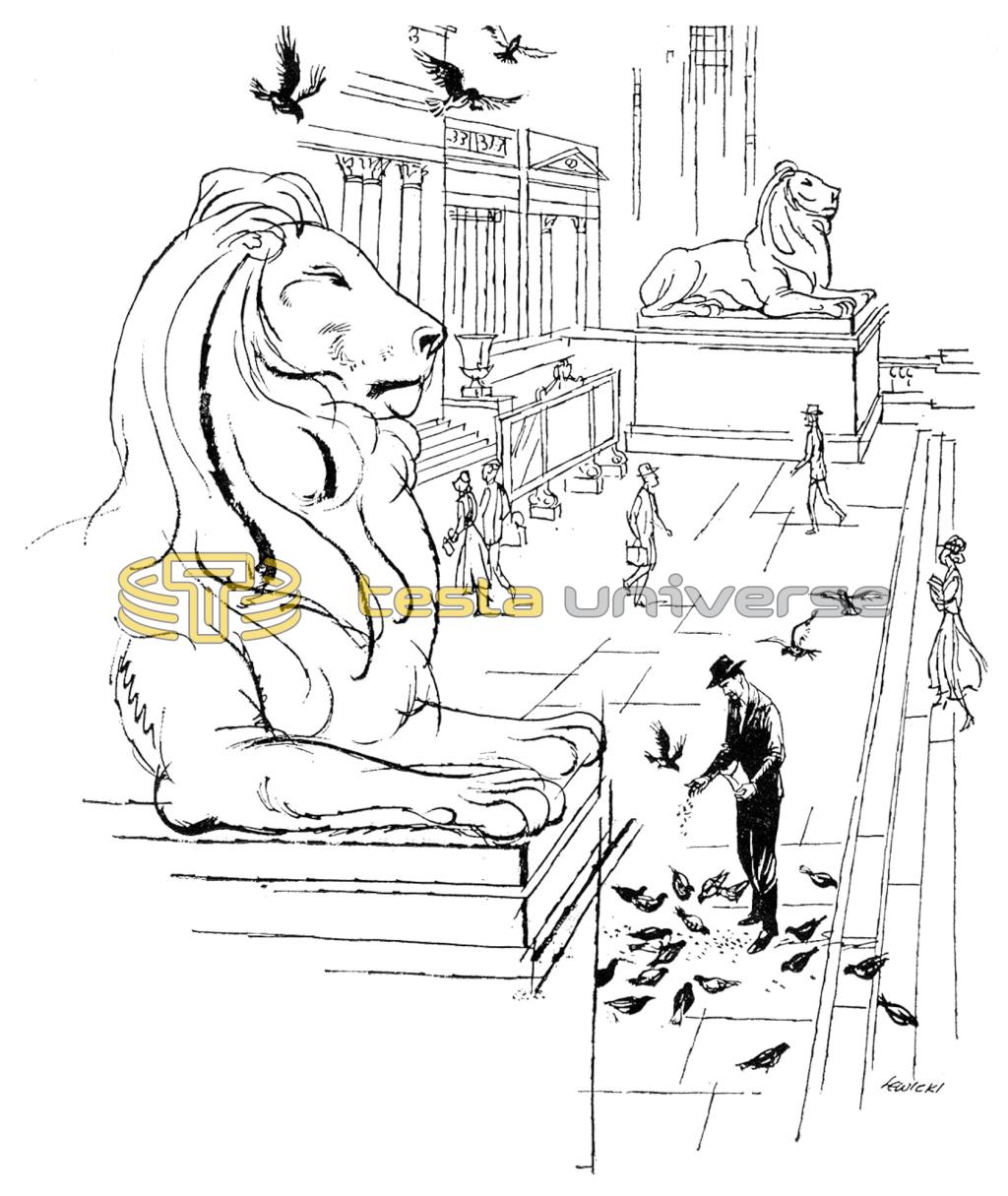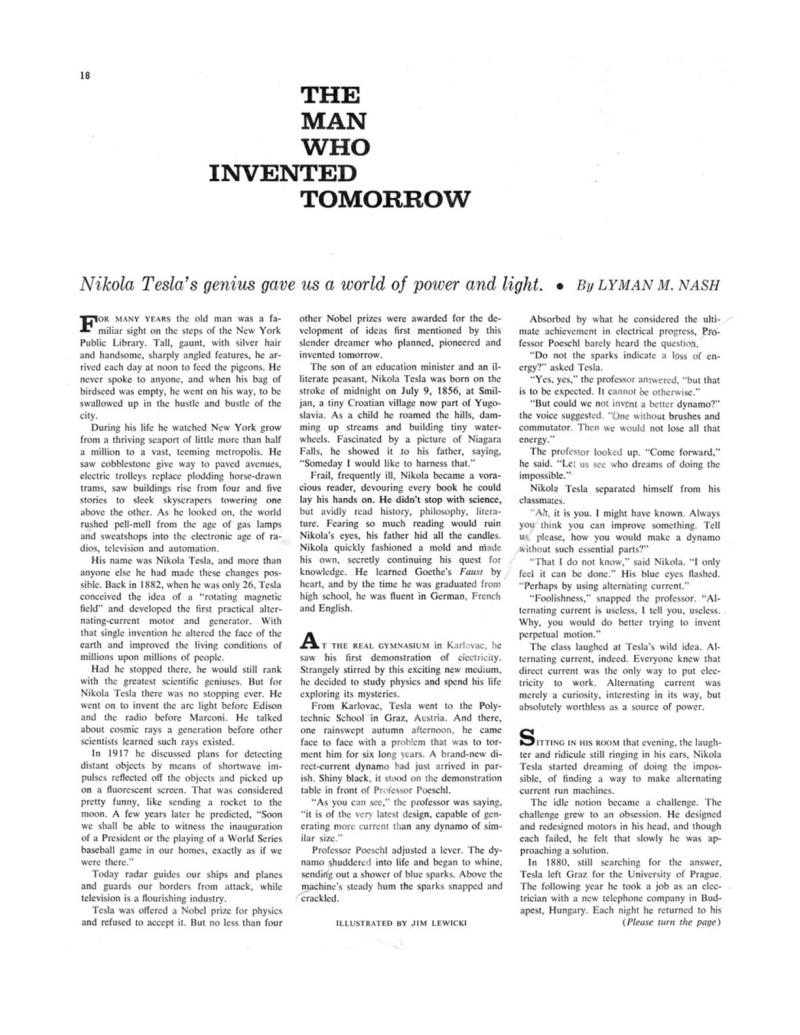
Nikola Tesla Articles
The Man Who Invented Tomorrow
Nikola Tesla’s genius gave us a world of power and light.
For many years the old man was a familiar sight on the steps of the New York
Public Library. Tali, gaunt, with silver hair and handsome, sharply angled features, he arrived each day at noon to feed the pigeons. He never spoke to anyone, and when his bag of birdseed was empty, he went on his way, to be swallowed up in the hustle and bustle of the city.
During his life he watched New York grow from a thriving seaport of little more than half a million to a vast, teeming metropolis. He saw cobblestone give way to paved avenues, electric trolleys replace plodding horse-drawn trams, saw buildings rise from four and five stories to sleek skyscrapers towering one above the other. As he looked on, the world rushed pell-mell from the age of gas lamps and sweatshops into the electronic age of radios, television and automation.
His name was Nikola Tesla, and more than anyone else he had made these changes possible. Back in 1882, when he was only 26, Tesla conceived the idea of a “rotating magnetic field” and developed the first practical alternating-current motor and generator. With that single invention he altered the face of the earth and improved the living conditions of millions upon millions of people.
Had he stopped there, he would still rank with the greatest scientific geniuses. But for Nikola Tesla there was no stopping ever. He went on to invent the arc light before Edison and the radio before Marconi. He talked about cosmic rays a generation before other scientists learned such rays existed.
In 1917 he discussed plans for detecting distant objects by means of shortwave impulses reflected off the objects and picked up on a fluorescent screen. That was considered pretty funny, like sending a rocket to the moon. A few years later he predicted, “Soon we shall be able to witness the inauguration of a President or the playing of a World Series baseball game in our homes, exactly as if we were there.”
Today radar guides our ships and planes and guards our borders from attack, while television is a flourishing industry.
Tesla was offered a Nobel prize for physics and refused to accept it. But no less than four other Nobel prizes were awarded for the development of ideas first mentioned by this slender dreamer who planned, pioneered and invented tomorrow.
The son of an education minister and an illiterate peasant, Nikola Tesla was born on the stroke of midnight on July 9, 1856, at Smiljan, a tiny Croatian village now part of Yugoslavia. As a child be roamed the hills, damming up streams and building tiny waterwheels. Fascinated by a picture of Niagara Falls, he showed it to his father, saying, “Someday I would like to harness that.”
Frail, frequently ill, Nikola became a voracious reader, devouring every book he could lay his hands on. He didn’t stop with science, but avidly read history, philosophy, literature. Fearing so much reading would ruin Nikola’s eyes, his father hid all the candles. Nikola quickly fashioned a mold and made his own, secretly continuing his quest for knowledge. He learned Goethe’s Faust by heart, and by the time he was graduated from high school, he was fluent in German, French and English.
At the Real Gymnasium in Karlovac, he saw his first demonstration of electricity. Strangely stirred by this exciting new medium, he decided to study physics and spend his life exploring its mysteries.
From Karlovac, Tesla went to the Polytechnic School in Graz, Austria. And there, one rainswept autumn afternoon, he came face to face with a problem that was to torment him for six long years. A brand-new direct-current dynamo had just arrived in parish. Shiny black, it stood on the demonstration table in front of Professor Poeschl.
“As you can see,” the professor was saying, “it is of the very latest design, capable of generating more current than any dynamo of similar size.”
Professor Poeschl adjusted a lever. The dynamo shuddered into life and began to whine, sending out a shower of blue sparks. Above the machine’s steady hum the sparks snapped and crackled.
Absorbed by what he considered the ultimate achievement in electrical progress, Professor Poeschl barely heard the question.
“Do not the sparks indicate a loss of energy?” asked Tesla.
“Yes, yes,” the professor answered, “but that is to be expected. It cannot be otherwise.”
“But could we not invent a better dynamo?” the voice suggested. “One without brushes and commutator. Then we would not lose all that energy.”
The professor looked up. “Come forward,” he said, “Let us see who dreams of doing the impossible.”
Nikola Tesla separated himself from his classmates.
“Ah, it is you. I might have known. Always you think you can improve something. Tell us, please, how you would make a dynamo without such essential parts?”
“That I do not know,” said Nikola. “I only feel it can be done.” His blue eyes flashed. “Perhaps by using alternating current.”
“Foolishness,” snapped the professor. “Alternating current is useless, I tell you, useless. Why, you would do better trying to invent perpetual motion.”
The class laughed at Tesla’s wild idea. Alternating current, indeed. Everyone knew that direct current was the only way to put electricity to work. Alternating current was merely a curiosity, interesting in its way, but absolutely worthless as a source of power.
Sitting in his room that evening, the laughter and ridicule still ringing in his ears, Nikola Tesla started dreaming of doing the impossible, of finding a way to make alternating current run machines.
The idle notion became a challenge. The challenge grew to an obsession. He designed and redesigned motors in his head, and though each failed, he felt that slowly he was approaching a solution.
Tesla’s mind was exceptional. He had only to think of an object and it seemed to appear before him. As a youngster this unique capacity made it difficult for him to tell the real from the imaginary. Now he was able to turn this handicap into an advantage.
While other men spent long hours working out ideas on a drawing board, Tesla merely envisioned a drawing board. On it he could design hour after hour, much faster than by using paper and pencil. These images he was able to file away in his brain, recalling them months or years later in exact detail.
Early in 1882 Tesla’s torment increased. If he managed to fall asleep, he dreamed of his motor running without a flaw. When he awoke, the motor stopped, and he would spend the rest of the night trying to get it going again. At times he thought he was on the brink of insanity and tried to put alternating current out of his mind. Then he would remember Professor Poeschl’s ridicule, the jeers accompanying it, and the burning obsession returned.
Walking through Budapest’s city park at dusk one day late in February, Tesla was reciting his favorite verse from Faust for his friend, Szigety. Suddenly he stopped. Before him he could see an iron motor spinning in a magnetic whirlwind.
“That’s it,” he shouted. “A rotating magnetic field. See how it causes the armature to turn?”
Szigety squinted into the darkening sky, but could see nothing.
“Notice how smoothly it runs. No sparks. No sputtering. Now watch while I reverse it.” Tesla reached out and flicked an imaginary switch. “See, it’s a generator now. Yes — yes, it works perfectly.”
Szigety saw only spidery branches silhouetted against cold, gray clouds. Tesla picked up a stick and quickly sketched the principles of his revolutionary idea in the sandy path. What he described was a machine that produced power when fed electricity, and produced electricity when powered mechanically or by steam.
Instead of one alternating current he would use three, each out of step with the other two. These currents, fed to windings around the stator, would create a constantly rotating magnetic field in which the rotor would spin, swiftly, silently.
“With this,” said Tesla, jabbing at the drawing in the sand, “I will change the world.”
Realizing the magnitude of his discovery, Nikola Tesla hastened to Paris to present his idea to the Continental Edison Company. But their business was supplying direct current. Alternating current did not interest them.
In the summer of 1883 Tesla built his first induction motor, and it ran exactly as he had seen it run in his imagination. Later he demonstrated the motor for a company official. The man was astounded.
“Take this to America,” he told Tesla. “They are more receptive to new ideas there. You might even interest Mr. Edison in your invention.”
Nikola Tesla arrived in New York in June, 1884, with four cents in his pocket and a book of poetry. Everything else — motor, clothes, scientific texts, his life’s savings — had vanished at the Paris railroad station.
A few hours after he landed, Tesla was standing in Edison’s office, perspiring in dark wool suit and high celluloid collar. Eagerly he described his invention, the words tumbling forth, at times in French, German or Croatian. Then he waited breathlessly for Edison’s reply.
Thomas Edison leaned back in his chair and steepled his fingers over his chest. For a long time he said nothing. Finally he shook his leonine head. “Interesting, but I’m afraid it’s not feasible.” He spoke with slow deliberation. “Direct current, that’s what the people want. Forget alternating current. It’s a waste of time.”
Tesla thought otherwise. Direct current was expensive and impractical, but since it was the only electricity available, people had no choice.
Edison had opened his first generating plant in 1881, delivering a weak current to 59 subscribers brave enough to invest in the newfangled incandescent light. Now, three years later, there were several thousand private power stations operating across the country, providing some 20 different direct-current systems. Because direct current could not be stepped down, one plant supplied electricity for house lights, another for street lamps, still another for factories.
In New York alone, a generating plant was required to light every few square miles, pumping out current, bringing it back, giving it a boost in pressure and sending it out again. What is more, direct current “leaked” from wires. Close to a station, lights burned bright, but half a mile away they were dimmer. A mile out they gave hardly any light at all.
Tesla knew his alternating current was far superior. It could travel great distances before meeting enough resistance to weaken it appreciably. And it could be stepped down, so one generating plant could furnish electricity to light a single bulb and run huge factories.
Although Edison dismissed Tesla’s invention, he did offer him a job. Tesla improved many of Edison’s basic designs and developed a small dynamo suitable for ships. One day he went to Edison with plans for a short-core dynamo with double the efficiency of the best long-core dynamo.
“Perfect it,” Edison said, “and there will be a bonus of $50,000 for you.”
For weeks Tesla worked every day from ten in the morning until five the next morning. At last, the task completed, he asked Edison for the promised bonus.
“My boy,” Edison said, “I’m afraid you don’t understand the American sense of humor.”
Furious at being the butt of a joke, Tesla quit. A minor depression was on, and the only work he could find was digging ditches. He worked at this for a year, then invented a new system of arc lighting for a small company, receiving for his efforts a stock certificate barely worth the paper it was printed on.
Fortunately, in 1887, Tesla came into sufficient funds to rent a loft building on New York’s Houston Street. There he pulled from the file of his brain his earlier visions and turned them into working machines of copper and iron. Soon he received his first historic patent and in 1888 was granted 13 more, for dynamos, motors, transformers, distributors, everything needed for an alternating-current system.
That same year he was asked to give a lecture before the American Institute of Electrical Engineers. Standing tall and proud, he described his system in detail, hoping someone with wealth and vision would appear to make it a reality.
Tesla found that person in George Westinghouse, a 42-year-old inventor who had made a fortune developing an air brake for railroad trains. Westinghouse, just getting started in electricity, had so much faith in the possibilities of alternating current that he paid Tesla $1,000,000 cash for the patent rights.
Edison immediately tried to get Congress to outlaw alternating current as dangerous and, when this failed. he instituted a campaign of propaganda against it. The war between AC and DC was a fiercely fought battle, raging up and down the United States. Tesla derived immense satisfaction from seeing his system gaining acceptance, but took little part in the conflict.
Once he completed an invention, he lost interest. To waste time putting it on a commercial basis, he considered standing still or, worse, going backward. As the two titans of electric power were locked in a life-and-death struggle. Tesla was racing on to new applications of electrical energy.
In 1893 Westinghouse underbid Edison for the privilege of lighting the Columbian Exposition at Chicago. Using Tesla’s system, he made it the electrical wonder of the world, the first world’s fair in history illuminated by electricity. That about ended the AC-DC war, with Tesla’s alternating current the clear-cut winner.
Perhaps to celebrate, Tesla took a stand at the exposition, demonstrating unique electrical gadgets and astounding spectators by passing hundred of thousands of volts through his body. Sparks danced from his fingertips, igniting wads of kerosene-soaked cotton. He lit bulbs between his teeth, and lamps in his bare hands glowed brightly.
Shortly afterward Tesla became interested in operating mechanical devices by electric
signals transmitted to them without wires. Four years before Marconi finished his first successful wireless set, Tesla was sending radio messages from his laboratory to a packet on the Hudson River, 25 miles to the north.
In 1897 he built and publicly displayed a true automation. It was it model boat which could be started, stopped, maneuvered, made to flash lights and fire small guns by means of radio signals. In Madison Square Garden he asked spectators to call out instructions which he broadcast to the boat by tapping a telegraph key.
At the century’s turn. Nikola Tesla was at the height of his fame. His childhood dream of harnessing Niagara Falls was a reality, and his alternating current was going from there to Buffalo and far beyond. Direct current had never been able to travel much over a mile.
Tesla became an American citizen and was hailed as our greatest adopted son. Although he stuffed his designs, models and patents into battered cardboard boxes, he kept his citizenship papers locked in a vault. “They are the most important papers I possess,” he once said. “They are my greatest gift.”
He pioneered experiments that led to discovery of rays, designed guided weapons and continued inventing new dynamos, transformers, condensers, as well as airplanes, steam turbines, and speedometers.
Twenty years before scientists identified electrons, he perfected a fantastic carbon-button lamp. Actually a cyclotron in miniature, it produced dazzling light by the bombardment of a small button of carbon with electrons.
To further his experiments In high-frequency current, he invented the “Tesla coil.” The only invention still bearing his name, it is the basis of every ignition and broadcasting system in use today.
Not all Tesla’s inventions were successful, but when he failed, he failed magnificently. Believing that cheap electric power would put an end to poverty, he worked out a plan for doing away with the millions of poles and insulators and the thousands of miles of copper wire needed to carry it from place to place.
Tesla knew the earth is electrically charged. Why not, he reasoned, add to this charge so people everywhere need merely plug into the ground to receive electricity? In Colorado he built a laboratory with an 80-foot tower topped by a 200-foot mast on which perched it copper ball, three feet in diameter. Tesla’s plan was to bombard the earth with millions of volts of electric energy, and the Colorado Springs Electric Company agreed to supply all the current he might need.
When the switch was thrown, sparks leaped from the copper ball, growing quickly into awesome lightning bolts that crashed to earth. Miles away 300 light bulbs connected to the ground began to glow. Then they went out, and so did the lightning flashes. His experiment had burned out the largest generator west of the Mississippi.
Returning to New York, Tesla immediately launched another venture for furnishing cheap electricity. He would broadcast it, along with entertaining programs. J. P. Morgan and several other prominent men put up $300,000, and Tesla began construction of a vast “radio city” at Shoreham, Long Island.
After completing a tall tower capped by an enormous copper dome, he ran out of funds. Unable to locate any more backers, he abandoned the project. The tower was dismantled at the outset of World War I, being considered too conspicuous a landmark.
In 1912 the Nobel prize for physics was offered jointly to Nikola Tesla and Thomas Edison. Although his share would have meant $20,000 and he was badly in need of cash, Tesla refused to accept. The memory of the unpaid $50,000 bonus still rankled, and he considered the placing of Edison, “a mere inventor,” on a par with Tesla, “a discoverer,” an affront.
Rather than award the prize to Edison alone, the Nobel committee voted it to Gustaf Dalen, a Swedish scientist.
Five years later, friends had to coax Tesla into accepting the Thomas Edison Medal, awarded annually by the American Institute or Electrical Engineers. In a presentation speech, B. A. Behrend, a noted engineer, said:
“Were we to seize and eliminate from our industrial world the result of Mr. Tesla’s work, the wheels of industry would cease to turn, our electric cars and trains would stop, our towns would be dark, our mills would be idle.”
The words meant little to Tesla. Already he was dreaming of new worlds to conquer. He saw cosmic-power stations, robots doing all the heavy labor, airplanes held aloft by radio waves. He proposed running and synchronizing world clocks by radio, visualized the transmission of letters and newspapers by radio, dreamed of inaugurating a worldwide printing system.
As the years rolled onward, Nikola Tesla probed deeper and deeper into the future. What he saw, what wonderful things he invented we will never know, for he could no longer afford to build the models needed to patent them, and until they were patented, he refused to discuss them. So he became a forgotten man in the electrical age that owed him everything.
On the night of January 7, 1943, at the age of 86, Nikola Tesla passed from this world as quietly as he had entered it. A few hours after his body was discovered, the FBI carried off his papers for whatever secrets they might reveal.
Although he died virtually in oblivion, his monument is all around us: humming in dynamos, singing in high tension wires, agleam in every light bulb and neon sign in every country of the world. A hundred years from now scientists will still be exploring fields first mentioned by this lonely genius who in the 19th century invented the 20th century and then went on to invent the 21st.



